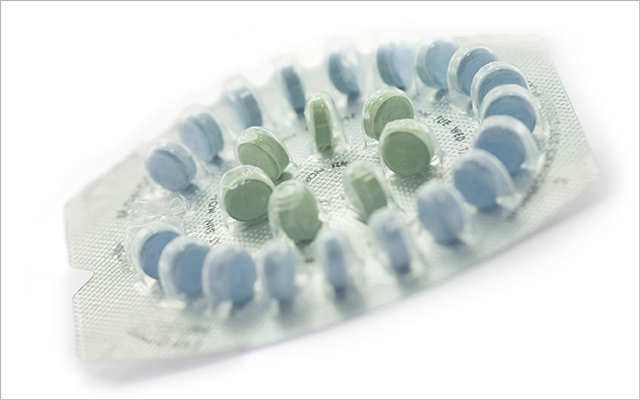Women tend to think a lot about fertility when they’re trying to achieve (or avoid) a pregnancy. Other times, not so much. Yet fertility is an important barometer of a woman’s overall health during her reproductive years, whether she plans to have children or not. Symptoms like irregular or difficult periods, PMS with mood swings, or an unexplained inability to conceive are signs that something is up — and not just with hormones.
“A woman’s reproductive health may signal a larger problem with her health in general and point to issues that may need attention as she ages beyond the reproductive window,” cautions gynecologist Sara Gottfried, MD, author of the New York Times bestseller The Hormone Cure.
Infertility affects more than 7.5 million U.S. women of reproductive age — about 12 percent of that population. The American Society for Reproductive Medicine defines it broadly as “a disease of the reproductive system,” a diagnosis generally given if a woman has been unable to conceive after a year of unprotected sex, or six months for those over 35.
Many couples who stall on the path to parenthood consult a reproductive endocrinologist. Testing may reveal ovulatory disorders, issues with the reproductive organs, or a male factor, such as low sperm count. (The National Institutes of Health [NIH] reports that the father’s infertility is the main obstacle about a third of the time.) But up to a third of couples are diagnosed with “unexplained infertility.” The cause remains unknown, which can be both exasperating and emotionally painful.
Conventional treatment usually involves drugs to stimulate the ovaries, though it’s largely trial and error. In vitro fertilization — where the egg is fertilized outside the body — is usually the last and most expensive recourse. (A single round can cost more than $20,000.)
By contrast, consultations with an integrative physician, naturopath, or midwife tend to focus on getting to the root cause or causes of the infertility. For many couples, the trouble is multifactorial; proper ovulation is only one of the conditions that enables a healthy pregnancy.
Susan Blum, MD, MPH, founder and director of the Blum Center for Health in Rye Brook, N.Y., and author of The Immune System Recovery Plan, says she always looks “at the foundational systems of the body, and not just the nuts and bolts of conception” for solutions to fertility issues.
This holistic approach — on its own or alongside conventional fertility treatments — can also lead to better overall health.
All Paths Lead to Inflammation
Blum, like most functional- and -integrative-medical practitioners, believes inflammation is the root of most health challenges, including infertility. Searching for a remedy without addressing inflammation, Gottfried says, is like trying to “clean up the house while a frat party is in progress.”
Pain, swelling, redness, and heat are inflammation’s four signature characteristics. “You can see it when it’s on the outside of your body,” says Blum, “but imagine that’s happening on the inside of your organs and you don’t even know it.”
Chronic inflammation involves constant immune activation; the body is flooded with inflammatory cytokines. This occurs when the immune system faces an overabundance of triggers, including environmental toxins, food sensitivities, and chronic stress.
Inflammatory responses can easily trigger early pregnancy loss. The successful introduction of an embryo requires the maternal immune system to distinguish between a hostile invader and a welcome guest, a process that has its roots in the evolution of mammalian reproduction, when some creatures evolved beyond laying eggs.
“The problem with eggs was that they were tasty and other animals ate them,” says Jeffrey Braverman, MD, a specialist in reproductive immunology in New York City. “So, creatures that could hold babies inside the body until they were fully developed began to evolve. This required a change in the immune system because these babies had paternal genetics that were foreign to the mother.
“This would normally trigger an immune rejection of the embryo,” he explains. Instead, mammals evolved to produce T-regulator cells to protect the embryo from the mother’s immune system.
When this protective mechanism fails — which can happen with autoimmunity, endometriosis, and chronic inflammation — it can often result in recurrent pregnancy loss.
“The immune system basically says, ‘We’re not going to protect this pregnancy because of all our signals from this state of inflammation,’” Braverman says.
Integrative fertility experts view inflammation as a critical aspect of multiple fertility issues.
Below are some insights into hidden factors that can wreak havoc on the reproductive system.
1. Autoimmune Disorders
Inflammation and autoimmunity are distinct processes, though they share a common tactic: They cause the immune system to target any perceived invader, including an embryo.
Researchers have identified upward of a hundred autoimmune disorders that cause the body to mistake its own tissues for intruders. Some of the more familiar varieties — Hashimoto’s thyroiditis, rheumatoid arthritis, and celiac disease — may be linked to conception failure and recurrent miscarriage.
Some 75 percent of autoimmune sufferers are women, so an early diagnosis is key for those seeking to get pregnant. Diagnostic results, however, can take some time — an average of four years and four doctors, according to the American Autoimmune Related Diseases Association.
Because there is such a wide range of autoimmune issues, it’s difficult to generalize about symptoms. “Fatigue and difficulty concentrating are big tip-offs,” says Blum. “But soreness anywhere that you can’t explain [and] injuries that aren’t getting better are signs of inflammation in your body.”
Unfortunately, early menopause (sometimes called premature ovarian failure), blood-clotting disorders that complicate pregnancy, and miscarriages can be among those symptoms. Recurrent miscarriage affects approximately 2 to 5 percent of reproductive-age women.
“Some people do walk in with a known diagnosis,” says Braverman, “but many times the [autoimmune] condition is silent, and the first symptom is miscarriage. When we look at the immune profiles, we see a propensity for autoimmune conditions like rheumatoid arthritis or lupus.”
What You Can Do: If you know you have an autoimmune condition, seek treatment before attempting to become pregnant. Immune regulation will be key to conceiving and sustaining your pregnancy.
If you suspect an issue, ask your doctor for testing, including an antinuclear antibody (ANA) test. Infertility is associated with higher counts of T cells, B cells, and natural killer cells, as well as antithyroid antibodies and antinuclear antibodies.
Finding your triggers is a critical first step; then work with your healthcare professional to manage them. “I could have three people with the same autoimmune disease sitting in front of me, and for one, stress could be the biggest player,” explains Amy Myers, MD, author of the New York Times bestsellers The Autoimmune Solution and The Thyroid Connection. “For somebody else, gluten or food sensitivities could be the biggest player. For somebody else, it could be toxins.”
In some cases, nutrition and lifestyle treatments can be enough to reverse these conditions or put them into remission, but supplemental thyroid hormones are sometimes needed. (For more on lifestyle remedies for autoimmune issues, see “Autoimmune Disorders: When Your Body Turns On You” and “Why Autoimmune Diseases Are on the Rise — Especially After COVID“.)
2. Thyroid Malfunction
Autoimmune issues involving the thyroid exert an especially potent effect on fertility. Hashimoto’s, an inflammatory response in which the body attacks the thyroid glands, accounts for 90 percent of hypothyroidism, and a 2014 study published in the International Journal of Endocrinology found that 47 percent of patients with Hashimoto’s had difficulties becoming pregnant.
Thyroid malfunction puts a woman at greater risk for anovulatory cycles, in which no egg is released, though she may still regularly get her period. Additionally, lower thyroid levels are associated with decreased sex hormone binding globulin, which can “interfere with growth and development of follicles and get in the way of proper FSH and LH [hormone] surges associated with ovulation,” according to Dana Trentini and Mary Shomon, authors of Your Healthy Pregnancy With Thyroid Disease.
Another thyroid-related condition, hyper-prolactinemia, also results in anovulatory cycles; it involves the overproduction of prolactin by the pituitary gland. Prolactin directs the body to make breast milk, and it inhibits ovulation during the first few months after giving birth to prevent another pregnancy during lactation. But if you’re not nursing and currently trying to get pregnant, this suppression is no help at all.
Finally, the thyroid helps convert pregnenolone — known as the “mother” hormone — from cholesterol into estrogen, testosterone, DHEA, and, most notably, progesterone. An underperforming thyroid can cause a deficit in any of pregnenolone’s offspring, but an insufficient amount of progesterone is especially problematic for fertility. It can lead to an abbreviated second half of the menstrual cycle, called the luteal phase, when the uterine lining builds up to host a fertilized egg. If this phase is abbreviated, there’s not time to create a suitable environment for a fertilized egg to implant.
Thyroid issues also make maintaining a pregnancy more difficult. “There are studies showing just having thyroid antibodies puts you at risk for miscarriage,” says Myers. Miscarriage rates for women with thyroid antibodies are two to three times higher than for those without them.
What You Can Do: If you often feel cold, have experienced inexplicable weight gain, or feel tired all the time, request a complete thyroid panel. Be aware that many physicians will order tests only on thyroid stimulating hormone and you may need to ask for a more complete analysis.
Alternatively, you can get feedback on thyroid function the old-fashioned way — through basal body temperature. “Temperature doesn’t lie,” says Myers. According to this method, pioneered in the 1940s by physician Broda Barnes, a waking temperature below 97.8 degrees F likely indicates hypothyroidism — even if this runs counter to your lab results.
Recommendations abound for dietary support. Aviva Romm, MD, author of The Adrenal Thyroid Revolution, suggests consuming plenty of iodine (sea vegetables are a good source) and avoiding large quantities of raw crucifers like broccoli and kale, which can suppress thyroid function.
Functional-nutrition and hormone coach Jill Grunewald, HNC, coauthor of The Essential Thyroid Cookbook, stresses the importance of healthy fats, which are vital for pregnancy in general. “The low-fat/no-fat craze did a disservice to women in many ways, including an increase in levels of infertility,” she says. “We make pregnenolone from cholesterol. It’s critical.”
For those with Hashimoto’s, giving up gluten is key. Even small amounts can set off an immune response. (For more on thyroid health, see “Repair Your Thyroid“.)
3. Food Sensitivities or Intolerances
Food sensitivities trigger low-level inflammation, making them potential suspects in any case of infertility. The same is true of food intolerances, which can occur when the body is deficient in an enzyme necessary to break down certain food substances, like lactose in dairy or gluten in wheat. If you have a food intolerance, eating even a small amount of the offending food can trigger systemic immune activation, causing widespread inflammation.
Unlike anaphylactic allergies that can close your airways upon exposure, the symptoms of food sensitivities can take up to 72 hours to set in and may seem counterintuitive. This makes them difficult to recognize. “How they’re manifested can be different in different people,” says Myers. “It could be headaches, swelling, digestive issues, or brain fog.” (For more on this, see below.)
What You Can Do: If you’re unsure whether you have sensitivities or intolerances, work with a practitioner who tests for and treats immunoglobulin G, or IgG, sensitivities. Avoid trigger foods and load up on anti-inflammatory whole foods and spices, like turmeric and ginger.
Be aware that these tests can produce false negatives. The gold standard for sleuthing out both food sensitivities and intolerances is an elimination diet, like the one created by the Institution for Functional Medicine. (See “The Institute for Functional Medicine’s Elimination Diet Comprehensive Guide and Food Plan“.)
4. Toxic Exposure
We’re products of our environment, and it has an impact on fertility. A 2005 study by the Environmental Working Group found 287 industrial chemicals, pollutants, and pesticides in the umbilical-cord blood of 10 U.S. newborns chosen at random. Many toxins have been shown to trigger inflammation, suppress the immune system, impair fertility, or result in pregnancy complications and birth defects.
One research study found higher blood concentrations of mercury in infertile couples. Another observed significantly higher levels of lead in the blood of infertile women. Experts posit that heavy metals damage the immune system’s ability to distinguish between the body’s own tissues and hostile invaders, creating the conditions for an autoimmune attack.
Among the other toxins with weighty implications are xenoestrogens — chemicals that mimic the body’s own estrogens. These can bind to estrogen receptors and create a condition called estrogen dominance, which upsets the delicate hormonal balance required for fertility. (Estrogen dominance can also increase the risk for breast cancer.) Xenoestrogens are ubiquitous in our environment, especially in personal-care products and plastics.
Blum notes that, while the majority of estrogen in most women’s bodies is produced by their ovaries, “it’s really all the external estrogens from toxins that are piling on to cause problems.”
One major source is bisphenol-A, or BPA, which is used to make plastics hard and shatterproof. It’s a known ovarian toxicant and may be a uterine toxicant as well. A 2016 study followed women through the process of in vitro fertilization: 54 percent with the lowest BPA exposure successfully delivered a baby compared with 17 percent with the highest exposure.
Parabens, found in body-care products, also mimic estrogens. Other endocrine-disrupting chemicals include phthalates, found in plastics, and perfluorooctane sulfonate and perfluorooctanoate, found in fabrics, carpets, food packaging, shampoo, nonstick cookware (think Teflon), insecticides, and other household items. All are associated with impaired fertility.
The liver is tasked with clearing toxins and estrogens, including xenoestrogens. Genetics, or rather alterations in a gene sequence known as SNPs, play a role in how well the liver performs this task. If it is unable to clear estrogens, this alone can lead to estrogen dominance. (For more on genetic variations, see “Making Sense of SNPs“.)
“Because of your genetics, you might accumulate more mercury from eating fish than someone else,” explains Blum.
What You Can Do: Stick with body-care products that contain five or fewer ingredients whenever possible. (For more, see “Beauty Beware“.)
Check your household for sources of lead. It’s found in the water from pipes in older homes as well as lead paint, which is rendered into toxic dust by the friction of opening and closing windows. Sources of mercury include seafood, cosmetics, dental fillings, and coal plants.
Avoiding plastics as much as possible is critical. Myers argues that most BPA-free plastics still leach dangerous chemicals into food and water, so she recommends replacing plastic water bottles and food containers with glass or stainless steel ones. BPA is also found in the lining of cans (look for brand labels that indicate they are BPA-free) and in cash-register receipts, where chemical exposure is literally at your fingertips.
For those who would like to investigate their specific detox genetics, a company called Genetic Genie will run a detox profile based on personal genome information acquired through direct-to-consumer genetic-testing companies, such as 23andme.
Whether you profile your genes or not, it’s wise to take a prenatal vitamin or supplement with folinic acid or 5-MTHF (also known as L-methylfolate), the active form of folate, if you’re having trouble getting pregnant. (See “Follow the Folate“.)
5. Chronic Stress
Chronic stress is “anything that overwhelms your body’s capacity to respond effectively to the challenges you’re exposed to,” explains Romm, and it can affect fertility by keeping the nervous system activated, triggering low-grade inflammation, and interfering with hormone production.
The pressures of infertility, of course, also contribute to overall stress loads. “The diagnosis [of] ‘unexplained infertility’ can leave people devastated and heartbroken,” says Grunewald. “It adds to the stress that could be preventing conception in the first place. There may be peace of mind in knowing what is behind your infertility, even if the news is not what you’d hoped.”
The hypothalamic-pituitary-adrenal axis, sometimes referred to as the stress circuit, is a feedback loop. In the event of a threat, it signals the brain to release inflammatory hormones, like adrenaline, which puts the body into fight-or-flight mode.
“If you’re in fight-or-flight,” says Grunewald, “it’s the opposite of feed and breed. The body’s ability to reproduce can be temporarily shut off.”
The primary stress hormone is cortisol, and its “main job is to raise glucose levels,” explains Gottfried. “The net result is that you get higher blood-sugar levels.” This can cause the body to resist insulin, requiring ever more of it, which has its own effects on hormones.
“High insulin seems to be directly toxic to the ovaries, causing higher production of testosterone,” she adds. This is one of the primary aspects of polycystic ovarian syndrome, a prevalent cause of infertility.
Progesterone is also a precursor for cortisol. “If you have a lot of stress — and it could be emotional stress, trauma, physical stress like chronic pain, or even ongoing inflammation [from infections] in the body that you’re unaware of — your adrenals are going to be pumping out cortisol, and it’s going to use up most of your progesterone,” explains Blum.
This, like external xenoestrogens, can lead to estrogen dominance, further depressing progesterone. High levels of cortisol can also slow down the thyroid, which can lead to anovulatory cycles.
What You Can Do: Relaxing, especially when infertility is an issue, is easier said than done. The goal is to find some deliberate ways to hit the pause button. Gottfried points out that “it’s not how much stress you have, but how you dance with it.”
On that score, studies have shown dancing and listening to music both lower cortisol levels. Pets are a proven stress buster. Although it may seem obvious, sleeping more, including short naps, also helps; sleep deprivation raises cortisol.
Beware of overexercising (which triggers cortisol), and consider switching from high-intensity to low-intensity activities — unless doing so would cause you more stress than it’s worth.
WEBEXTRA
Allergy, Intolerance, or Sensitivity?
By Laine Bergeson
When it comes to differentiating between an allergy and a sensitivity or intolerance, not all tests are created equal.
Traditional allergy tests register positive only when a food or other toxicant triggers an antibody called immunoglobulin E, or IgE. The presence of IgE in the body tells cells to produce histamines “with explosive force,” says Leo Galland, MD, a New York City–based functional-medicine practitioner. It is that instant flood of histamines that is responsible for the acute symptoms of an allergy, from sneezing and eye-watering to full-blown anaphylaxis. (Anyone who has been relieved of an acute allergic reaction by antihistamine drugs understands the IgE reaction intimately.)
But some irritants don’t trigger the IgE antibody pathway — and, hence, don’t show up on conventional allergy tests. Instead, they trigger the immunoglobulin G, or IgG, pathway, which leads to inflammatory symptoms like migraines, joint pain and arthritis, and abdominal pain. The most likely triggers for this pathway are particular foods. These reactions are often called sensitivities or intolerances rather than allergies, as they involve a subtler, nonhistamine reaction.
IgG reactions are difficult to detect because symptoms can set in up to 24 hours after exposure — and sometimes longer. When there’s a gap that long between a trigger and a stomachache or migraine, it can take some sleuthing to work out the cause. If you suspect a hidden intolerance or sensitivity, find a practitioner who tests for and treats IgG-type sensitivities. Those tests may include fecal and breath tests.
You can also try an elimination diet to see if it offers relief from digestive and other symptoms. (Download the elimination diet guide from the Institute for Functional Medicine.)
Laine Bergeson is a health journalist, functional-nutrition educator, and holistic health coach.
This WEBEXTRA originally appeared in “Taking on the Allergy Epidemic” in the April 2017 issue of Experience Life.
This originally appeared as “The Roots of Infertility” in the September 2017 print issue of Experience Life.





This Post Has 2 Comments
Hey Lara,
I have read a lot of blog posts but haven’t heard about this topic. This, the topic of unexplained fertility, should be addressed as women get to know about the actual causes of unexplained fertility from posts like this.
Thanks for sharing such information.
Infertility is not the end of the road, it’s a detour towards alternative paths to parenthood.